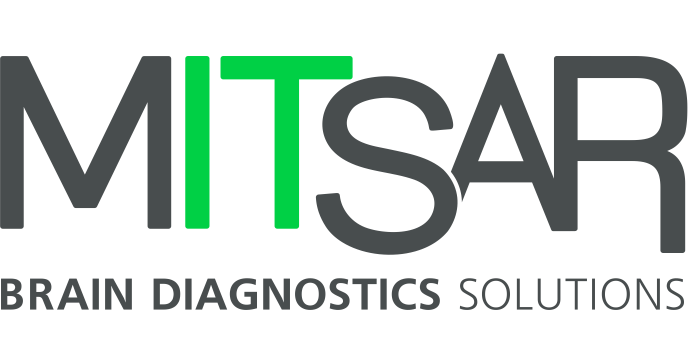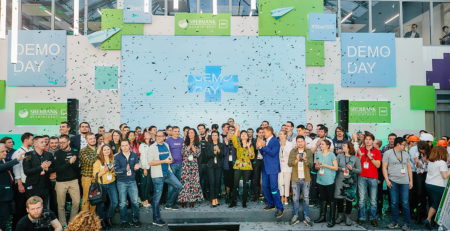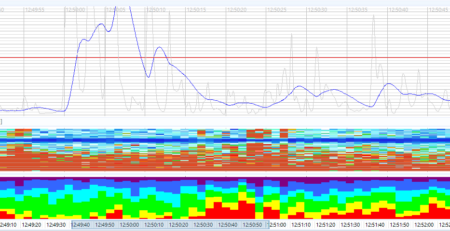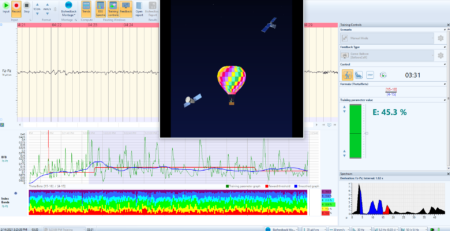ADHD and Neurofeedback training

The use of Neurofeedback for Attention Deficit Hyperactivity Disorder.
Attention Deficit Hyperactivity Disorder (ADHD) is a big social problem as a lot of children have it. The origin of ADHD is genetic mechanisms, organic brain damage, and psychosocial factors. Children and adolescents suffering from ADHD are characterized by restlessness, distraction, hyperactivity, impulsivity, poor school performance, fatigue. These symptoms may be the result of reduction of activation level of frontal cortex in combination with dysfunction of non-specific trunk structures and midbrain.
An integrated approach to the diagnosis of ADHD involves an objective quantitative assessment of the symptoms using both clinical and neurophysiologic, psychological, psychophysiological diagnostic methods.
Neurophysiologic diagnosis of ADHD children is carried out with the help of electroencephalographic examination methods. In our work for diagnostic purposes we use the Mitsar-EEG electroencephalograph (St. Petersburg). The bioelectric activity of the brain of such children is characterized by: increased theta and delta activity in the anterior cerebral cortex and a decrease of beta rhythm in these areas in the range of 12-21 Hz (Mann CA et al., 1992, Yu.Kropotov, 2005). These peculiarities of bioelectric brain activity structure indicate a significant predominance of synchronizing nonspecific influences and a deficit of activating influences, which results in a decrease of activation level of neocortical structures that is optimal for realization of involuntary attention. Chabort and Serfonstein (1996) identified two main types of EEG changes for children with ADHD: the first type is characterized by an increase in theta rhythm at a normal frequency of alpha rhythm; the second type is characterized by an increase in theta activity, accompanied by a decrease in the average frequency of alpha rhythm. V. Monastra et al. (2001) report that the ratio of the power spectra of theta rhythm and beta rhythm of children with ADHD is several times higher than of healthy children, which indicates a slight slowdown in the bioelectric activity of the brain in these areas. Slow EEG patterns peculiar to these children may also reflect a change of neurotransmitters function of these areas. The use of quantitative EEG helps to objectively assess the degree of disorder of attention and determine the protocol for Neurofeedback procedures.
A quantitative assessment of disorder of attention and impulsivity is carried out by means of TOVA psychophysiological test (The Test of Variables of Attention) – a continuous activity test, which is an option of the GO / NOGO test that allows you to estimate the number of omissions of significant stimuli (inattention errors) and the number of false clicks (impulsivity errors) in relation to regulatory data. The test is included in the PSYTASK stimuli presentation software hat is part of Mitsar-EEG system for ERP research.
The test is based on the presentation to trainee significant and insignificant stimuli in the form of geometric figures. The test is divided into two relative parts, not separated by a break. In the first part, a significant stimulus is presented in 22.5% of cases, in the second part a significant stimulus is presented in 77.5%. The test has a regulatory database. TOVA data include an assessment of inattention (omission error of significant stimuli), impulsivity (the number of false alarms), reaction time, and standard deviation of reaction time.
The results of a comprehensive diagnosis allow making differentiated therapy of ADHD, taking into account the type and severity of the disease, the presence of certain comorbid disorders.
Since for EEG patients suffering from ADHD an increase of theta activity and decrease of beta activity is typical, BFB training is usually aimed to increase fast activity of beta-1 band with simultaneous suppressing theta activity. An increase of theta band power of anterior cerebral cortex is associated with distractibility, while increase of beta-1 activity level at 15-18 Hz frequency is associated with concentration and effective cognitive activity.
It was found that the combination of Neurofeedback with drug therapy gives more evident and stable therapeutic effects than the use of the drugs only. Moreover, Neurofeedback turns to be effective even without drug therapy (Monastra et al., 2002).
According to M.B.Schtark and A.B. Skok (1998), NEUROFEEDBACK, changing the functional parameters of EEG can affect the state of cerebral blood flow and neurotransmitter functions. V.A. Grin-Yatsenko (2001) proved that the BFB effectiveness of beta-1 rhythm and sensorimotor rhythm in the correction of attention and behavior disorders is associated with influence on the restoration of the normal functioning of the system of actions selection.

Usually, the Neurofeedback protocol for ADHD includes an increase of beta activity power (13-20 Hz) while reducing the amplitude or percentage of the theta activity and suppressing EMG activity (Sandberg S., 1996; Linden M. et al., 1996). In cases of significant hyperactivity, it is recommended before beta/theta training to have 20 – 30 sessions of CMR training (S.Sandberg, 1996). In some publications Neurofeedback protocol is differentiated depending on the age of the patient. So, according to early research of J.F. Lubar (1984) children and adolescents under 14 years selectively suppressed theta activity (4-8 Hz); adults over 20 years performed increased beta activity (16-20 Hz) and CMR training (12-15 Hz); and for patients aged 14 to 20 years a combined training option was used: suppression of theta activity with simultaneous increase of power of beta-1 rhythm.
Usually, to facilitate Neurofeedback procedure they use visual, acoustic, and less often tactile signals (M.A. Tansey, 1993; T.R. Rossiter, T.J LaVaque 1995). Visual feedback is provided by changing the size, color, brightness of the image and other parameters of the object on the screen depending on power of controlled EEG rhythm or on ratio of EEG rhythms.
In some cases, the feedback object appears on the screen if the power of increased activity exceeded the specified threshold by at least 0.5 seconds. In some cases, the visual signal is supplemented by an acoustic feedback signal. This can be a nice melody, which is switched on if the amplitude of the current wave exceeds a predetermined threshold (or did not reach it if the task is to suppress activity), or a change of a sound volume or pitch of tone depending on amplitude of waves band selected for training.
According to J.F. Lubar (1998), long-term retention of positive changes in behavior, in learning performance, in relationships with peers and parents, is ensured by inclusion of academic activity in training program. According to the author, despite the fact that there is a lot of data on autonomous regulation without awareness, the clinical results are more evident if the patient understands what has to be done to change the nature of the bioelectric activity of his brain.
Our studies showed that after the course of Neurofeedback (beta training), clinical improvement was in 73.5% of all the children with ADHD aged 9 to 15 years who underwent the training. Parents reported that the children became more concentrated during classes at school and when doing homework, were less distracted during lessons, did the tasks faster, gradually school marks improved, motivation for studying at school appeared. Significant positive changes occurred in the behavior of patients: hyperactivity reduced, relationships with peers were improved, though there were the conflicts before. Undesirable and side effects were not observed (L.Chutko, 2007)
Evaluation of the condition using the SNAP-IV scale after an Neurofeedback course (beta training) shows a significant reduction of inattention (increased attention), hyperactivity parameters reduction, and a slight reduction of impulsivity parameters.
Thus, accurate and reliable positive dynamics of hyperactivity parameters and, especially, inattention was recorded. Quantitative EEG data indicated an increase in beta-wave power with a simultaneous reduction in theta-wave power in the anterior sections of the cerebral cortex after an Neurofeedback course. After Neurofeedback course of children group aged 9-10 years, an increase in peak frequency of alpha rhythm was observed if the peak frequency of alpha band was 7-8 Hz on EEG recorded before the course of the Neurofeedback, as well as reduction of the rhythm synchronization in the alpha band. A second psychophysiological study using the TOVA test revealed a statistically significant decrease of carelessness after the treatment. Follow-up studies showed that the changes that appeared after the course of NEUROFEEDBACK (beta-training) persisted for 24 months in 57.6% of cases.
Neurofeedback approach for ADHD treatment is used in many clinics (MB Schtark, AB Skok, 1998; J.F Lubar, 1984; Linden M. et al., 1996; Sandberg S., 1996). This method normalizes action selection, gives positive effect on mechanism reconstruction of suppression of prepared response, and on restoration of normal activation of cerebral cortex (T.R. Rossiter, T.J. LaVaque 1995).
Course of SMR training is recommended for ADHD children with predominance of hyperactivity and impulsivity. Our experience shows that after the course hyperactivity was reduced, attention was improved, distractivity was reduced, self-control was increased.

Our brand new 2 channel wireless and wearable trainer Mitsar-BFB together with EEGStudio software is ready for neurofeedback training of patients with ADHD and other neurological diseases.
- 2 bipolar DC channels
- Bluetooth wireless interface
- Real-time impedance values
- Low noise DC amplifier
- Less than 100 gramm
Thus, the Neurofeedback is a highly effective and safe treatment for ADHD children and adolescents. Neurofeedback is a drug free therapy for ADHD and many other disorders.





Comments (2)
Please send information on your product
Please, be so kind to send us an e-mail or connect via feedback form in Contacts section! Let us know your location, please, we might have local representative in your country!